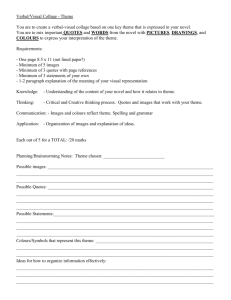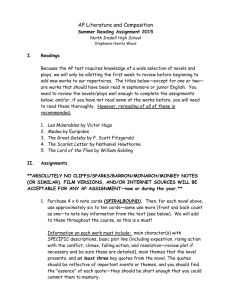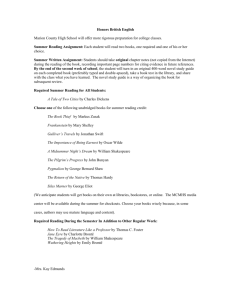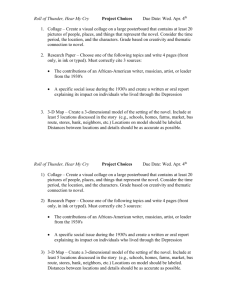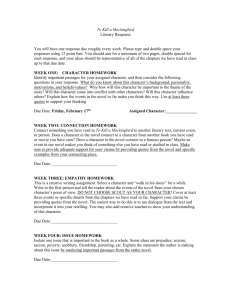Summer Reading - AP Literature & Composition - Trinity
advertisement
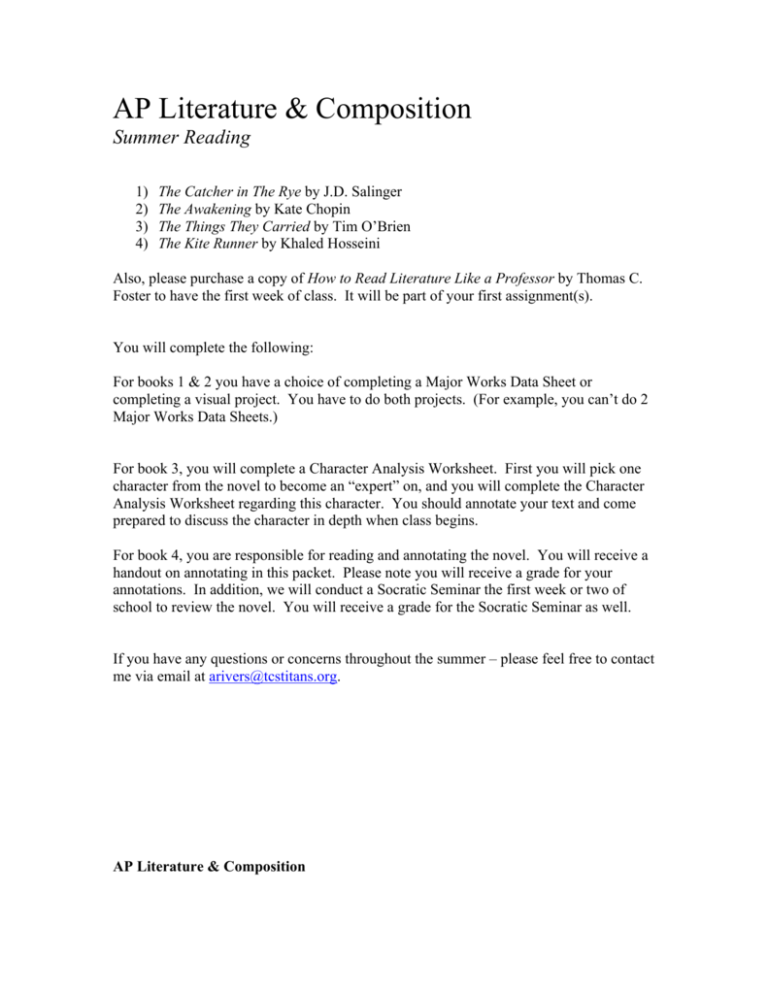
AP Literature & Composition Summer Reading 1) 2) 3) 4) The Catcher in The Rye by J.D. Salinger The Awakening by Kate Chopin The Things They Carried by Tim O’Brien The Kite Runner by Khaled Hosseini Also, please purchase a copy of How to Read Literature Like a Professor by Thomas C. Foster to have the first week of class. It will be part of your first assignment(s). You will complete the following: For books 1 & 2 you have a choice of completing a Major Works Data Sheet or completing a visual project. You have to do both projects. (For example, you can’t do 2 Major Works Data Sheets.) For book 3, you will complete a Character Analysis Worksheet. First you will pick one character from the novel to become an “expert” on, and you will complete the Character Analysis Worksheet regarding this character. You should annotate your text and come prepared to discuss the character in depth when class begins. For book 4, you are responsible for reading and annotating the novel. You will receive a handout on annotating in this packet. Please note you will receive a grade for your annotations. In addition, we will conduct a Socratic Seminar the first week or two of school to review the novel. You will receive a grade for the Socratic Seminar as well. If you have any questions or concerns throughout the summer – please feel free to contact me via email at arivers@tcstitans.org. AP Literature & Composition The Awakening by Kate Chopin The Catcher in the Rye by J.D. Salinger Pick one of the novels above to complete a Major Works Data Sheet. You can find this in the packet or online on the website. With the other novel, you are to complete a visual project. PLANNING FOR YOUR VISUAL: (for use with The Awakening or The Catcher in the Rye) Create a collage of quotations from your choice novel from above that illustrates the following: OPTION 1: Universal Theme Ambition, Guilt, Power, Love, Trust, Manhood, Friendship….. You reflect & decide which theme works for you. (Does not have to be from the above list) OPTION 2: Characterization Choose a major character from the work as the focus of the collage OPTION 3: Devices Pick a literary device or devices and collage quotes/events that illustrate this device: Foreshadowing, dramatic irony, imagery, conflict, etc 1. Pick a choice novel & option from above. 2. Brainstorm ideas to use on the collage. 3. Locate 4-5 quotes that reflect the work’s treatment of this idea. Copy these passages along with page number so that you will have them for use on the project. 4. Look through magazines, computer clip art, cartoons, online pics, etc. Choose pictures that symbolically represent your topic and neatly cut them out of scan/copy/paste/ them using a computer/scanner and/or software program for editing. OR if you artistically inclined you can create your own! 5. Organize the images into a planned layout & cover the ENTIRE surface of the paper – 8.5x11 or larger. (remember to plan where you will put the quotes, title, etc) 6. Integrate the quotes onto the work to show the novel’s treatment of the topic (be sure to include page number). Type these or write on unlined paper and paste as a top layer OVER the pictures…being careful not to cover up an important image. 7. Entitle the collage with the topic you chose (must be LARGER in font than other text on the collage) Type or write on unlined paper & paste as a top layer over the pics. 8. Include the work’s title and author. METACOGNITIVE REFLECTION: Write a metacognitive reflection that explains your choice on components for the project and ties the theme/character traits to the work. • • • • • In your thesis statement, include the purpose of your writing, the title and author of the work and your topic. In your introductory paragraph, explain the meaning of the topic you chose – its significance and how it is conveyed through the work as a whole. Explain why you chose MOST of your images/symbols and HOW each one represents the theme/character/element you are conveying. Explain HOW each of your selected quotes/passages represents the theme/character/element as well. Refer to the quotations by paraphrasing them if you wish. Finally, discuss the overall significance of your topic within the novel’s content. Explain what you learned about the theme/character/element from reading. Annotation Strategies: (ideas not requirements) For use with either The Awakening or The Catcher in The Rye Tracking nouns/important people/places/things/ideas: • You can put boxes around characters when they are introduced • • • • You should look for changes in setting You can mark objects that seem significant On the inside cover of the book – you can list characters you encounter You can list different themes as you encounter them (note the section or page numbers) Creating chapter summaries: • At the end of a chapter, write a brief summary of the plot • Jot note relevant incidents • Look for shifts in the plot development Underlining: • • • • Underline anything that strikes you as important Write brief comments in the margins Focus on literary elements Don’t underline whole passages – pick words/phrases/quotes Using Vertical Bars: • Use bars to separate ideas or to mark off an important passage • Be sure to comment or snippet to explain your markings Indicating Vocabulary & Diction: • Circle words that are unfamiliar • Look up the words • Consider connotation/denotation • Consider synonyms for the words Questioning: • Actively engage the text by creating and documenting questions you have • Take time to think of open ended questions you could ask regarding a chapter Documenting Shifts: • Note all shifts in point of view, time, setting, etc. FINAL THOUGHTS: Think critically when you are reading and about what you are reading! Name: _______________________________________ Annotation Rubric Annotations Number of annotations Excellent Good Adequate but needs improvement Lacks AP quality; requires more Consistent frequency of entries throughout text (not bunched) Significance of commentary Variety of topics: character, theme, POV, plot, and other literary elements Selections for diction, detail, syntax are appropriate and annotated Annotations are keyed to specific passages by symbols, shorthand, or highlighting Comments on key scenes, lines, ending… TALKS THE TALK!!! TOTAL: Note: Posts-its and annotations directly in text will be read randomly. Please make them specific enough in reference to the page that their meaning can be discerned. Without highlighting they are more difficult to assess, so the responsibility is on you to make the post-its detailed. Do not use random pieces of paper or post-its torn in half. GRADE: _______________________ CHARACTER ANALYSIS WORKSHEET (For use with The Things They Carried by Tim O’Brien) Character ____________________________ DRAMATIC ACTION Remember that a character is determined ONLY AFTER his actions, not before. First, analyze the character’s wants and desires. Look over the course of the novel. OBJECTIVE (Desire or Victory) This is a statement of what a character wants most; power, dominance over others, love for another, integrity, dominance over fear, etc. OBSTACLE (Other) This is the person or thing that is preventing him from getting what he wants. What or who is standing in his way? From whom does he want it? Who can help him? Who can hurt him? TACTIC (Will) This is a character’s relative strength in attaining his wants or desires. How can he get what he wants? How (and whom) can he threaten? How (and whom) can he induce? How strong or weak is his inner strength? Is it strong enough to push him the full limit, or will he compromise? Does he have any sense of moral responsibility to others? How honest is he with others and with himself? (a character’s moral stance will affect the attainment of his wants and desires) EXPECTATION (Resolution) Every character has 5 basic Human Needs. These, in one way or another, ultimately become what the character expects to get. What does the character expect by the end? Why does he expect to get it? Why does it excite him? What will he do when he gets it? 1) Winning 2) Survival 3) Validation DRAMATIC ACTION involving your character 1. What do others say about this character? 2. What does this character say about others? 3. What discoveries does this character make? 4) Love 5) Happiness CHARACTERIZATION INTERNAL 1. Background (what you know of their upbringing or life at home) 2. Mental (intellect/common sense, right/left brain…) 3. Spiritual (religion, beliefs and values) 4. Emotional (calm, angry, gentle…when and why) 5. Apparent Fears EXTERNAL 1. Appearance 2. Movement (bounce, sway, swagger, …) 3. Posture (slouched, straight, leads with head/hips/chest….) 4. Voice (pitch, rate, volume, inflection, quality) 5. Mannerisms (habits the character does)
